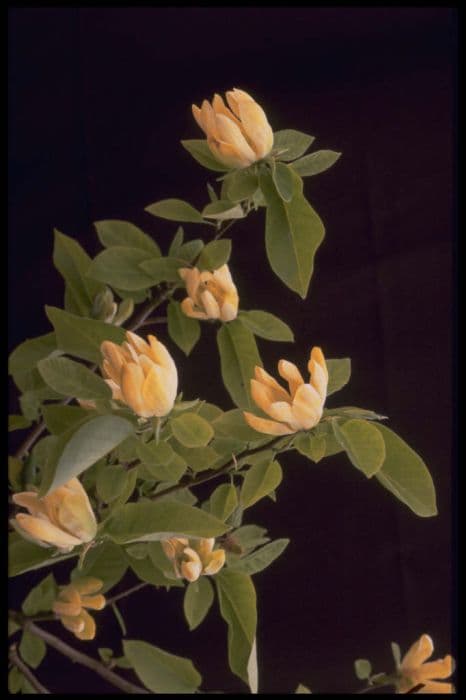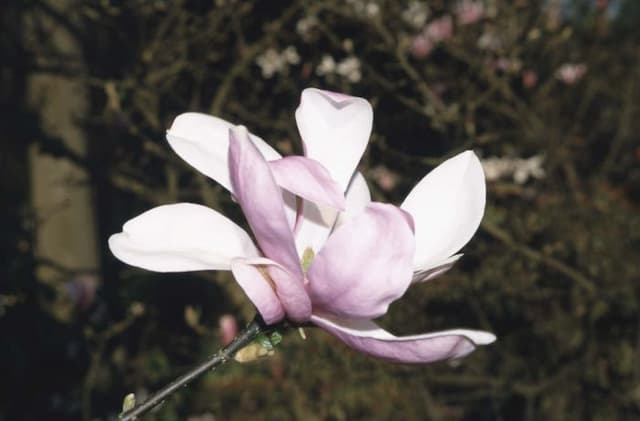Magnolia Magnolia 'Athene'

ABOUT
The Magnolia 'Athene' is a stunning ornamental plant known for its large, creamy-white flowers which are accented with a hint of pink at the base. These gorgeous blooms, resembling ancient goblets, give off a pleasant fragrance that can enliven any garden space. The petals exhibit a waxy texture, and when fully open, they fan out to display a striking contrast against the dark green leaves. These leaves are glossy and leathery, providing a lush backdrop for the flowers. Magnolia 'Athene' has a dignified presence in any landscape, accentuated by its flowers which appear before the leaves in early spring, heralding the end of cold weather. Its graceful appearance and aromatic flowers make it a favored choice for ornamental planting, offering a visual and olfactory feast.
About this plant
 Names
NamesFamily
Magnoliaceae
Synonyms
Athene Magnolia
Common names
Magnolia 'Athene'.
 Toxicity
ToxicityTo humans
Magnolia 'Athene', commonly known as Magnolia, is not considered toxic to humans. However, ingesting plant parts in large quantities can potentially cause stomach upset or other gastrointestinal discomfort.
To pets
Magnolia, including the 'Athene' cultivar, is also not generally considered toxic to pets. However, if pets consume large amounts of the plant material, they may experience mild gastrointestinal upset. It is always prudent to monitor pets if they have ingested any plant material, and consult a veterinarian if any concerning symptoms arise.
 Characteristics
CharacteristicsLife cycle
Perennials
Foliage type
Deciduous
Color of leaves
Green
Flower color
White
Height
20 feet [6 meters]
Spread
15 feet [4.5 meters]
Plant type
Tree
Hardiness zones
7
Native area
Cultivar
Benefits
 General Benefits
General Benefits- Aesthetic Appeal: Magnolia 'Athene' has large, showy flowers that are highly decorative and can add significant beauty to gardens and landscapes.
- Fragrant Flowers: The flowers of the Magnolia 'Athene' are known for their pleasant fragrance, which can enhance the sensory experience of a garden.
- Year-Round Interest: With evergreen leaves, this plant offers visual interest even during the winter months, when other plants may have lost their leaves.
- Shade Creation: The tree can provide ample shade once fully grown, making it a practical addition for creating cooler areas in a garden or yard.
- Wildlife Attraction: Magnolia 'Athene' can attract a variety of wildlife, including birds and pollinators like bees, which contribute to a healthy ecosystem.
- Privacy: When planted in a row or as a screen, Magnolia 'Athene' can provide a natural privacy barrier.
- Low Maintenance: The plant is relatively easy to care for, requiring minimal pruning and moderate watering, making it suitable for low-maintenance landscapes.
- Hardiness: It is quite hardy and can withstand cold temperatures, which makes it suitable for planting in a variety of climates.
- Structural Garden Element: Its size and form make Magnolia 'Athene' a great structural element in garden design, helping to establish a focal point.
 Medical Properties
Medical Properties- This plant is not used for medical purposes.
 Air-purifying Qualities
Air-purifying QualitiesThis plant is not specifically known for air purifying qualities.
 Other Uses
Other Uses- Magnolia 'Athene' petals can be crystallized and used as edible decorations for cakes and pastries, providing a floral flavor and a touch of elegance to desserts.
- The sturdy wood from Magnolia 'Athene' is occasionally utilized in furniture-making for its fine texture and workability.
- Extracts from the leaves and bark can be used in the perfume industry for their aromatic qualities, adding a subtle, exotic note to fragrances.
- Dried magnolia flowers can be incorporated into potpourri mixes, offering a long-lasting scent and a touch of color to a room.
- The tree's large, glossy leaves are used in floral arrangements to add a backdrop of greenery that enhances the appearance of colorful flowers.
- Dried seed pods from Magnolia 'Athene' can become part of art and craft projects, such as wreaths or natural ornaments.
- Magnolia 'Athene' blossoms are sometimes used in specialty teas for a floral flavor note, particularly in East Asian tea blends.
- Photographers and artists may use the striking flowers and elegant form of the Magnolia 'Athene' as subjects for their work, capturing the beauty of the plant.
- Magnolia 'Athene' seed cones can be collected and used for educational purposes, demonstrating seed dispersal and plant reproductive processes to students.
- The aromatic properties of the Magnolia 'Athene' can be captured in scented candles to bring a natural, floral fragrance into homes.
Interesting Facts
 Feng Shui
Feng ShuiThe Magnolia is often associated with purity and nobility in Feng Shui, and can be used to bring a calming, serene energy into a space. Placing a magnolia in the garden or home can promote a sense of peace and tranquility, and it is especially beneficial in the East sector to enhance health, or in the Southeast to attract abundance and prosperity.
 Zodiac Sign Compitability
Zodiac Sign CompitabilityThe Magnolia is not used in astrology practice.
 Plant Symbolism
Plant Symbolism- Nobility: Magnolias are often associated with nobility, due to their impressive appearance and stature in the natural world.
- Dignity: The magnolia's grand and upright form symbolizes a dignified character and self-respect.
- Persistence: As a plant that has existed for millions of years, magnolias represent endurance and long-lasting life.
- Feminine beauty: With its delicate and beautiful blossoms, the magnolia is frequently seen as a symbol of feminine beauty and gentleness.
- Purity: The pure white color of many magnolia blooms is associated with purity and innocence.
 Water
WaterFor a Magnolia 'Athene', which is commonly known as a Saucer Magnolia, the watering needs to be thorough but infrequent. The plant benefits from deep watering to encourage a strong root system. This means that the soil should be soaked to a depth of at least 12 inches. During the growing season, it’s usually sufficient to water once a week, depending on the weather conditions and soil type. Saucer Magnolia typically requires 1 to 1.5 gallons of water each time for a young tree, increasing as the tree matures and the root system expands. In the case of prolonged dry spells or extreme heat, the frequency may need to increase. It is essential to avoid overwatering and ensure good drainage to prevent root rot.
 Light
LightSaucer Magnolias perform best in full sun to partial shade. They need at least four hours of direct, unfiltered sunlight each day, but can benefit from some afternoon shade in hotter climates. An ideal spot would provide morning sunlight and some protection from intense afternoon heat.
 Temperature
TemperatureSaucer Magnolias are tolerant of a range of temperatures but prefer a moderate climate. They thrive when daytime temperatures are between 60°F and 70°F. The plant can survive minimum winter temperatures down to about 0°F but is at risk of damage if temperatures drop lower. The Saucer Magnolia’s ideal growing conditions include avoiding locations where temperatures fluctuate wildly, particularly in the spring when frosts can damage flowers.
 Pruning
PruningPruning of a Saucer Magnolia should be done selectively to maintain shape and remove any damaged or diseased wood. This typically occurs after blooming in late spring to early summer, as pruning earlier can remove flower buds. Older trees don't often need much pruning aside from removing deadwood. Prune sparingly, as Magnolias do not heal as quickly as some other trees, and too much pruning can cause stress to the tree.
 Cleaning
CleaningAs needed
 Soil
SoilMagnolia 'Athene', commonly known as Athene Magnolia, thrives in acidic to neutral soil with a pH of 5.5 to 7.0. The ideal soil mix should be rich, well-draining, and contain organic matter such as peat moss or compost to retain moisture. Incorporating perlite can enhance drainage, crucial to avoid root rot.
 Repotting
RepottingAthene Magnolias require repotting every 2 to 3 years to ensure healthy growth. Being relatively slow growers, these plants do not need frequent repotting; however, it is important to refresh the soil and check for root health during the repotting process.
 Humidity & Misting
Humidity & MistingAthene Magnolia prefers a moderate humidity level, but it is adaptable and can tolerate the varying humidity levels commonly found in a home or garden environment, without requiring any special humidity adjustments.
 Suitable locations
Suitable locationsIndoor
Provide bright indirect light and keep soil consistently moist.
Outdoor
Plant in partial shade, shelter moist, well-drained, acidic soil.
Hardiness zone
7-9 USDA
 Life cycle
Life cycleThe Magnolia 'Athene' begins its life as a dormant seed, requiring a period of cold stratification to overcome dormancy. Once germinated, the seedling gradually develops into a young plant with a sturdy stem and characteristic leaves. As it matures, the Magnolia 'Athene' enters a vegetative state where it focuses on producing a strong root system and abundant foliage. After a few years, it reaches maturity and starts to produce large, fragrant flowers typically from late winter to early spring, with some cultivars flowering intermittently throughout the summer. The flowers are followed by cone-like fruit that release seeds, potentially generating new plants. Throughout its life, the Magnolia 'Athene' goes through cyclical periods of growth, flowering, and dormancy, especially in temperate climates.
 Propogation
PropogationPropogation time
Spring-Early Summer
The most popular method for propagating the Magnolia 'Athene' is via softwood cuttings. This involves taking a cutting from a healthy, young shoot in late spring or early summer, when the wood is still soft and green. The cutting should be about 3 to 6 inches (7.5 to 15 cm) long, with a few leaves left at the top and the rest removed. The cut end of the stem cutting is then dipped in rooting hormone to encourage root growth and planted in a mixture of peat and perlite or a well-draining potting soil. The cutting should be kept moist and placed in indirect light until roots have developed, which can be checked by gently tugging on the cutting after a few weeks to feel for resistance. Once roots have established, the new Magnolia 'Athene' plant can be gradually acclimated to outdoor conditions and then transplanted to its final location.


![Magnolia [Black Tulip]](/_next/image?url=https%3A%2F%2Fplants-admin.emdemapps.com%2Fimages%2Fplants%2F%2Fimages%2F604b590290fc7.png&w=640&q=75)


![Magnolia [Fairy Blush]](/_next/image?url=https%3A%2F%2Fplants-admin.emdemapps.com%2Fimages%2Fplants%2F%2Fimages%2F604b5a108e959.png&w=640&q=75)



